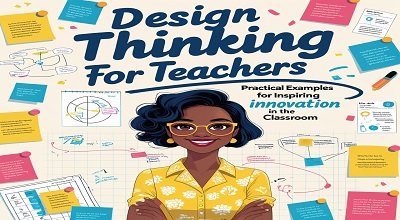Design thinking for teachers
Design thinking for teachers is a dynamic, human-centered approach to problem-solving that emphasizes empathy, creativity, and iterative learning. For educators, it offers a powerful framework to reimagine teaching practices, foster student engagement, and address complex challenges in the classroom. By integrating design thinking into education, teachers can cultivate critical thinking, collaboration, and innovation among students.
Understanding Design Thinking
Design thinking is a problem-solving methodology that involves understanding user needs, redefining problems, and creating innovative solutions through iterative processes. It encourages a deep understanding of the end-user, promotes brainstorming of creative ideas, and involves prototyping and testing to refine solutions.
The Design Thinking Process in Education
The design thinking process typically involves the following stages:
- Empathize: Understand the experiences and motivations of students to gain insights into their needs.
- Define: Clearly articulate the problem based on insights gathered.
- Ideate: Generate a range of creative ideas to address the defined problem.
- Prototype: Develop tangible representations of selected ideas to explore potential solutions.
- Test: Evaluate prototypes with students, gather feedback, and refine solutions accordingly.
Implementing Design Thinking in the Classroom
Educators can apply design thinking to various aspects of teaching:
- Curriculum Design: Developing lesson plans that address student needs and encourage active participation.
- Classroom Management: Creating strategies that foster a positive and inclusive learning environment.
- Assessment Methods: Designing assessments that provide meaningful feedback and support student growth.
Real-World Examples
- Project-Based Learning: Students engage in projects that require them to solve real-world problems, promoting critical thinking and collaboration.
- Inclusive Education Strategies: Implementing Universal Design for Learning (UDL) to accommodate diverse learning styles and needs.
- Technology Integration: Utilizing tools like interactive whiteboards and virtual reality to enhance learning experiences.
Benefits of Design Thinking for Teachers and Students
- Enhanced Engagement: Students take ownership of their learning, increasing motivation and interest.
- Improved Problem-Solving Skills: Students learn to approach challenges methodically and creatively.
- Collaborative Learning: Encourages teamwork and communication among students.
- Adaptability: Prepares students to navigate complex, real-world situations with confidence.
Challenges and Considerations
- Time Constraints: Implementing design thinking can be time-consuming and may require adjustments to existing schedules.
- Resource Availability: Access to materials and technology can impact the feasibility of certain projects.
- Professional Development: Teachers may need training to effectively apply design thinking methodologies.
Conclusion
Design thinking empowers educators to create more engaging, inclusive, and effective learning environments. By focusing on empathy and iterative problem-solving, teachers can better meet the diverse needs of their students and prepare them for the complexities of the modern world.
FAQs
Q1: What is design thinking in education?
A1: Design thinking in education is a problem-solving approach that emphasizes understanding student needs, fostering creativity, and developing innovative solutions through iterative processes.
Q2: How can teachers implement design thinking in their classrooms?
A2: Teachers can implement design thinking by incorporating project-based learning, encouraging student collaboration, and using iterative feedback to refine teaching strategies and materials.
Q3: What are the benefits of design thinking for students?
A3: Benefits include enhanced engagement, improved critical thinking and problem-solving skills, increased collaboration, and better preparation for real-world challenges.
Q4: What challenges might educators face when applying design thinking?
A4: Challenges can include time constraints, limited resources, and the need for professional development to effectively apply design thinking methodologies.
Q5: Where can educators find resources to learn more about design thinking?
A5: Educators can explore resources from educational organizations, attend professional development workshops, and collaborate with peers to learn and share best practices in design thinking.
Free Here: Apex Legends Mobile APK
